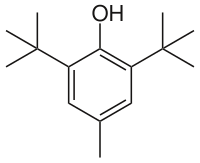
Photo from wikipedia
Synthetic phenolic antioxidants can interact with peroxides produced by food. This paper reviews correlation between BHA, BHT and TBHQ metabolism and harms they cause and provides a theoretical basis for… Click to show full abstract
Synthetic phenolic antioxidants can interact with peroxides produced by food. This paper reviews correlation between BHA, BHT and TBHQ metabolism and harms they cause and provides a theoretical basis for rational use of BHA, BHT and TBHQ in food, and also put some attention on the transformation and metabolic products of PG. We introduce BHA, BHT, TBHQ, PG and their possible metabolic pathways, and discuss possible harms and their specific mechanisms responsible. Excessive addition or incorrect use of synthetic phenolic antioxidants results in carcinogenicity, cytotoxicity, oxidative stress induction and endocrine disrupting effects, which warrant attention. BHA carcinogenicity is related to production of metabolites TBHQ and TQ, and cytotoxic effect of BHA is the main cause of apoptosis induction. BHT carcinogenicity depends on DNA damage degree, and tumour promotion is mainly related to production of quinone methylation metabolites. TBHQ carcinogenicity is related to induction of metabolite TQ and enzyme CYP1A1.
Journal Title: Food chemistry
Year Published: 2021
Link to full text (if available)
Share on Social Media: Sign Up to like & get
recommendations!